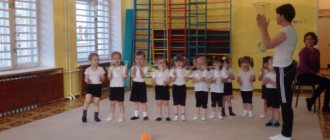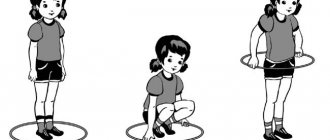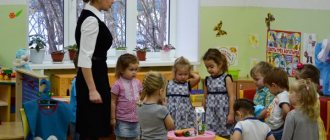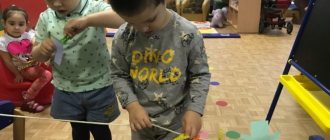Exercises for developing motor skills in children from six months to 12 months
From 6 months the baby begins a new stage. Having mastered the basic movements, increased the strength of the muscles of the arms and legs, and sufficiently strengthened the back, the baby begins to prepare for learning the skill of walking. To make it easier to overcome this stage, it is good to use a number of exercises added to the basic gymnastics.
- Crawling Basics.
While lying on your stomach, fix one foot with your hand, the other leg must be bent several times. After this, leave the baby’s leg in a bent position, placing a support with your free hand. The baby, obeying a reflex, will push away from her. Repeat with the second leg.
- I am sitting.
With your baby lying on his back, offer him two thumbs to grasp. Holding your hand with your other fingers, help your baby independently lift his torso to a sitting position. Secure the little one for a few seconds and lower them back. Repeat the exercise. After mastering this exercise, make it more difficult by asking your child to stand up on his own, holding only one hand.
- Corner.
While lying on your back, grab your baby's legs by the shins and lift them up at a 90-degree angle. Lock the element. Lower it back down. Repeat several times.
- Tilts.
After fully mastering the skill of sitting, you need to move on to learning to walk. To do this, you need to further strengthen your back muscles. Raise the baby to his feet, holding him by the waist. Help him bend down and get up. Repeat several times.
- Let's get up.
From a lying position, help your baby first sit up, then stand up, holding your hands. Let him get used to the new position.
Having sufficiently developed the muscles of the back, arms and legs, and understanding the principle of raising one’s own torso, the little one will quickly begin to try to rise in the game, grabbing hold of nearby objects. During this period, you need to be very careful and not leave the baby unattended at heights.
Each child develops at his own speed and masters basic skills in his own time. For this process to proceed easily and quickly, the baby needs your help. Using the exercises described, you stimulate the necessary muscle groups, pushing the body to quickly master new capabilities.
When preparing for the birth of a baby, remember that success in mastering knowledge and skills goes hand in hand with the physical maturation of the body. Your attentive attitude to the development of motor functions, harmonious growth and formation of all internal systems is the path to a smart and healthy toddler.
If you liked the article, please share a link to it
Exercises to develop motor skills in children under 6 months
A set of exercises for children from birth to six months is introduced gradually during a daily massage and involves a gradual familiarization of the baby with basic movements, the development of muscle groups that allow him to gradually master the necessary skills (holding his head, turning over from his back to his stomach and back, the ability to sit).
Basic rules for conducting the lesson:
- 30 minutes passed after eating;
- The baby is in a good mood;
- The duration of the exercises starts from 10 seconds, gradually increasing to 5-10 minutes;
- Comfortable hard surface covered with a diaper;
- Good mood of baby and mother.
It is recommended to do the exercises with background classical or other music. Don't worry or be afraid when introducing new exercises. Carefully watch the baby's facial expression; at the slightest change in mood, stop doing it and go to the baby's usual warm-ups.
Physical education with a baby. Where to begin
- Laying on the stomach.
The first and main exercise for a newborn baby is placing the baby on his stomach to strengthen the muscles of the neck and back. Initially, this is carried out once a day for a few seconds, gradually increasing the number of approaches (up to 3 times a day by one month), lengthening the interval of being in the prone position to 10 seconds, by three months the duration increases to 30 seconds.
- Walk.
Exercises with baby's legs help strengthen the muscles of the back and legs. Having laid the baby on his back, take his shins in your hands and slowly lift them one by one towards his tummy. After repeating the exercise 5 times, lift both legs together towards your tummy. Move your legs in a circle, simulating a bicycle ride. Raising two legs to the tummy, slowly spread them apart, bringing the baby into a frog position.
- Claps.
Take your baby in your arms, offering him your thumb to grab. Bend your baby's arms at the elbows. Lift up. Bring it together.
- Grab it.
At about 2 months, you can offer your thumbs to the baby lying on his back for gripping. It is good to use various rattles, attracting the baby's attention to the sound from both sides.
- Raising the body.
Having learned to grab your thumbs, the baby will begin to strive to rise. There is no need to help him with this. Let your hands be at the same level, raise higher only with the child’s shoulders lifting yourself.
- Reach out.
At three months, the baby will already be able to hold his head well when lying on his stomach. To develop the muscles of the neck and spine, it is good to stimulate keeping the body on the elbows and reaching for a toy placed in front of the eyes.
- Revolutions.
Place your baby on his back. Take his right hand and place it behind his left shoulder, lifting the baby’s body. Allow your baby to roll over onto his stomach on his own. Repeat the exercise on the other side.
These exercises can continue to be used after the baby reaches six months of age as a basic complex, eliminating unnecessary ones as new ones are learned.
MBDOU ZATO Severomorsk d/s No. 8
Tasks:Educational:
-strengthen physical and mental health;
- exercise the ability to walk and run in a flock without bumping into each other.
-develop the ability to correctly perform jumps through 2 parallel lines, pushing off with both legs and landing softly;
- to form stable balance when walking on a gymnastic bench;
- strengthen the ability to crawl under an arc and straighten up;
-enrich and activate children’s motor experience.
Educational:
-Develop attention, fine motor skills of fingers and toes; spatial orientation skills, psychophysical qualities: speed, agility.
Educational:
-Cultivate interest in physical education, evoke joy and a sense of satisfaction from joint gaming activities.
-Health: help strengthen the physical and mental health of preschoolers.
Material: 2 walnuts for each child; arch, gymnastic bench; cord, 2 jump ropes, toy bun.
Progress of the lesson:
Part I – Introductory part.
Organizing time
Kolobok: Hello guys! I was walking through the forest and got lost. Help me get home to my grandparents.
Educator - Guys, can we help the bun? (Yes!)
We walk along the path (they walk one after another, the teacher walks backwards, carries Kolobok in his hand and invites us to look at him).
We begin to stomp loudly (stomp).
Through a puddle, a stream, jump-jump, jump-jump (jumping with forward movement).
We walk on pebbles, keeping up with each other (Corrective walking on massage paths with buttons (prevention of flat feet)
Well, if they weren’t tired, they quickly ran (running after each other or in a flock).
And now we will rest, we will walk quietly (calm walking)
Part II – Main part
General development exercises:
Educator: Here we come to the lawn, where there is a basket of pine cones. Kolobok: Guys, take two cones and let's play!
1) “Show and hide the cones” (I.P. - basic stance, arms down, cones in hands)
Where are the kids' bumps? Hidden from the bunny! We'll show you one, we'll hide two, well done guys!! (4-5 times)
2) “The Christmas tree grows in the forest” (I.P. - sit down, pine cones in your hands)
The Christmas tree in the woods was 2 years old, it grew for a year, it grew for two years, it grew higher than the sky (stand up, straighten up, stretch, stretch your arms with cones up. 4-5 times)
3) “Collect cones” (I.P. - sitting, legs apart, cones in hands)
We will collect the cones and put them in a basket. (tilt the body towards the toes, put the cones, straighten up, bend over, take the cones. Repeat 4-5 times).
4) “Arms and legs rest” (I.P. – lying on your back, raise your arms and legs up, wave them)
We are a little tired, arms and legs are resting (waving their arms and legs)
5) “Fun Jumping”
We have so much fun playing, we will jump together (jumping in place near the cones). How fun we played, and now we’ll put all the cones in the Kolobok basket.
Main types of movements:
1) Standing long jump.
How far is the path? Kolobok is in a hurry to go home. He rolled to the river, jumped over, landed (Jumping, pushing off with both legs, across a “river” made of two jump ropes (15 cm wide);
2) Walking on a bench.
We will walk along the bridge and come straight to grandma (walk along the bench one after another)
3) Climbing under the arc
Here is the gate in front, you need to crawl under it (climb under the arc, stand up, straighten up, reach for the sun)
Outdoor game “Sun and Rain”
Oh, guys, we haven’t reached our grandparents’ house yet, it looks like it’s starting to rain!
Let's hide from the rain under an umbrella! (2-3 times) The rain has stopped!
Part III – final
Guys, do you know who almost ate Kolobok in this fairy tale? (fox) Imitation exercise “Sly little fox.”
Let's turn into foxes and walk like a sly fox.
Here is my grandparents' house, goodbye, Kolobok!



